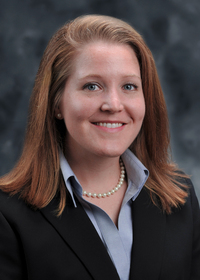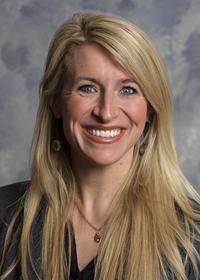Minimizing Risk when Operating a Farmers Market
Farmers market season is here, but opening amid the COVID-19 pandemic can be challenging. Below are some tips to help keep vendors, customers, and yourself safer when direct selling farm products.
Currently, there is no evidence that food, food packaging, or food containers are associated with the transmission of COVID-19. Like other viruses, it is possible that the virus that causes COVID-19 can survive on surfaces or objects. However, the main transmission is thought to be directly from person to person.
Remember: It is important to follow local, state, and federal guidelines and ordinances as you open your market. Note that guidance may be updated based on new evidence at any time, so you must have a way to stay informed and updated with regulatory-entity information and procedures.
Promote good hygiene and a safe environment.
- Encourage customers and vendors not to attend the market if they are showing symptoms of COVID-19.
- Encourage all who attend to wear face coverings or masks while shopping.
- Encourage customers to send only one household representative to the market.
- Have handwashing or sanitation stations available.
- Enforce social distancing of 6 feet.
- Encourage market employees and vendors to wash their hands (best) and/or use hand sanitizer.
- Have different employees handle products and money, or have employees clean their hands when switching tasks to prevent cross-contamination.
- Provide trash cans to eliminate litter.
- Encourage and remind patrons to leave the farmers market when they are done shopping.
- Do not allow or provide products for sampling. Samples should not be offered at this time.
- Clean and disinfect surfaces as often as appropriate using an EPA-approved disinfectant.
Update logistics, layout, and design of the farmers market.
- Control entrances and exits to limit the number of people shopping in the space, especially if crowd limitations are in effect in your area.
- Post signage asking customers to stay 6 feet away from one another when in line or visiting the booths.
- Rope off areas and add arrows to show customers where to stand and how to move through the farmers market.
- Spread vendor booths farther apart to prevent gathering, crowding, or close proximity to other lines.
- Allow only nonporous tables, and require tablecloths that can be easily cleaned and disinfected.
Make shopping easy for both the vendor and the customer.
- Minimize customer interaction with products.
- Ask customers not to touch products unless they are ready to purchase them. Another option is to ask customers to point at the item they want so the vendor can package it for them.
- Encourage vendors to offer pre-bagged and pre-packaged items.
- Encourage vendors to put together meal-kit boxes to sell as one item.
- Examples include salad kits, toppings for a veggie pizza or veggie pasta salad, or summer soup kits. Work with your local MSU Extension office to put together some meal-box ideas and recipes.
- Ask vendors to price items evenly to reduce the need for change.
Offer curbside, pick-up, or delivery options.
- Encourage vendors to conduct pre-orders with their customers.
- Encourage vendors to contact their local MSU Extension office for help setting up a social media page. (This does not apply to cottage food vendors.)
- Promote as many of the vendors on the farmers market social media page as possible. (Check with the Mississippi Department of Health for social media regulations on cottage food vendors.)
- Ask vendors to use pre-paid or online payment options to reduce handling of money, which will help prevent cross-contamination.
- Designate a market opening time for elderly customers.
Communicate and provide signs.
- Communicate frequently with vendors and customers.
- Post all market changes on social media pages, websites, and other mass-communication outlets.
- Post signs to communicate the following messages:
- Anyone who is sick and showing symptoms is not allowed at the market and will be asked to leave.
- Farmers market management reserves the right to ask visitors to leave at any time if they are showing signs of sickness or if they are not adhering to market guidelines (social distancing and safe practices).
- Maintain social distance of 6 feet.
Resources
Minimizing Risks for Coronavirus Transmission at Farmers Markets, On-Farm Markets, You-Pick Operations, and Produce Auctions
Considerations for Mississippi Farmers Markets Related to COVID 19
FOOD: A Guide for Farmers Markets to Navigate the COVID-19 Outbreak
Coronavirus Disease 2019 (COVID-19) Frequently Asked Questions
List N: Disinfectants for Use Against SARS-CoV-2
M2349-1 Minimizing Risk when Operating a Farmers Market large signs (24" by 36")
M2349-2 Minimizing Risk when Operating a Farmers Market posters (11" by 17")
M2349-1 and M2349-2 contain the posters shown below.
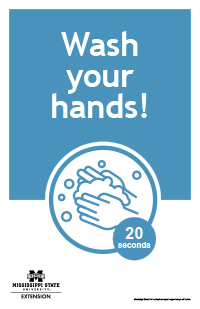
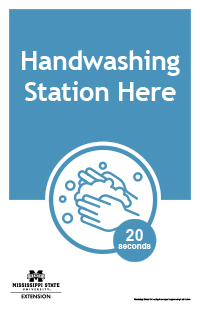
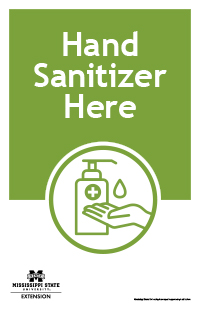
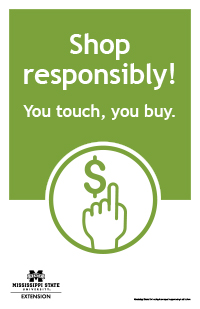
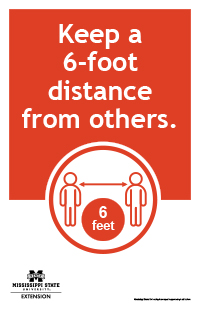
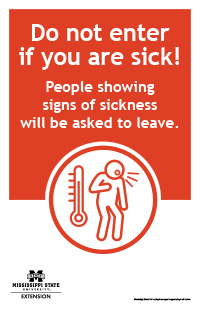
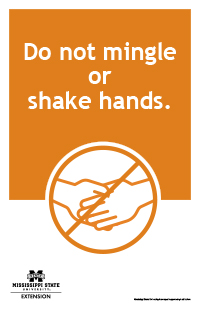
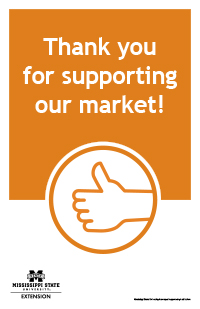
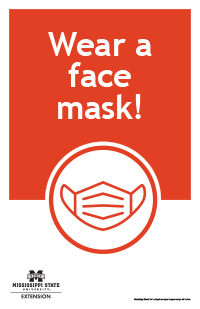
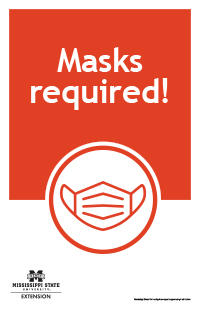
M2349 (POD-05-23)
By Courtney Crist, PhD, Associate Extension Professor, Food Science, Nutrition, and Health Promotion; Rachael Carter, PhD, Extension Specialist, Extension Center for Government and Community Development; and Lauren Colby Nickels, Extension Instructor, Extension Center for Technology Outreach.
The Mississippi State University Extension Service is working to ensure all web content is accessible to all users. If you need assistance accessing any of our content, please email the webteam or call 662-325-2262.


